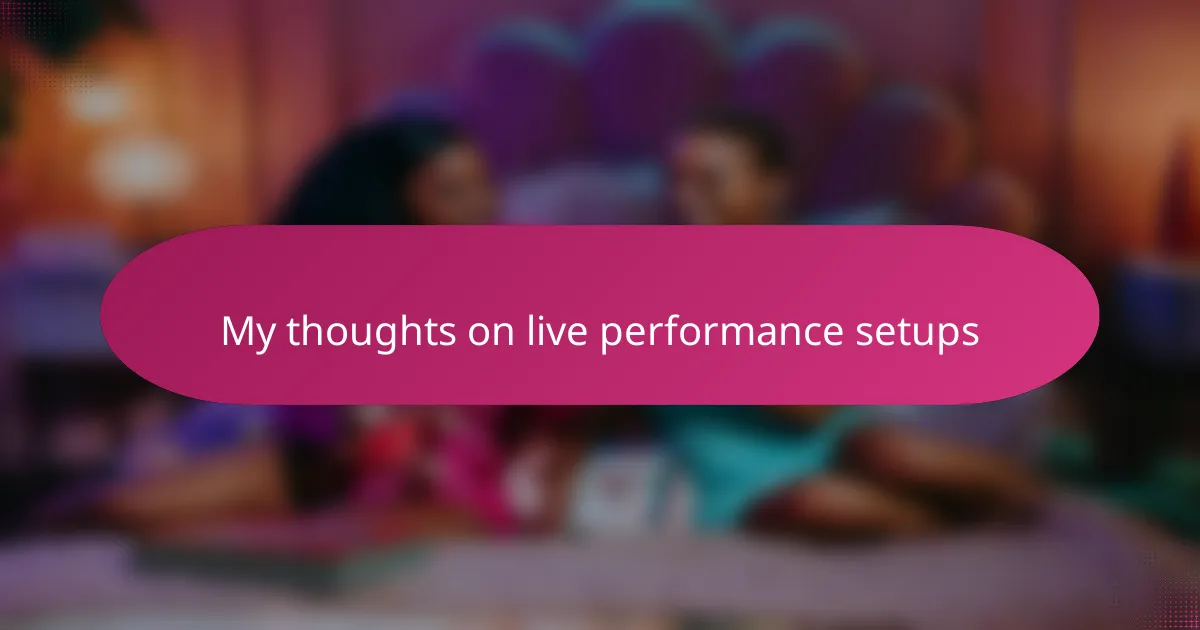Key takeaways
- Live performance setups require careful consideration of sound engineering, equipment placement, and artist style for a successful show.
- Essential equipment includes high-quality microphones, well-placed monitors, and effective mixers for optimal sound clarity.
- Stage arrangements should prioritize movement and connection with collaborators, enhancing both performance flow and audience engagement.
- Preparation for technical challenges and maintaining audience connection are vital for turning unexpected moments into memorable highlights.
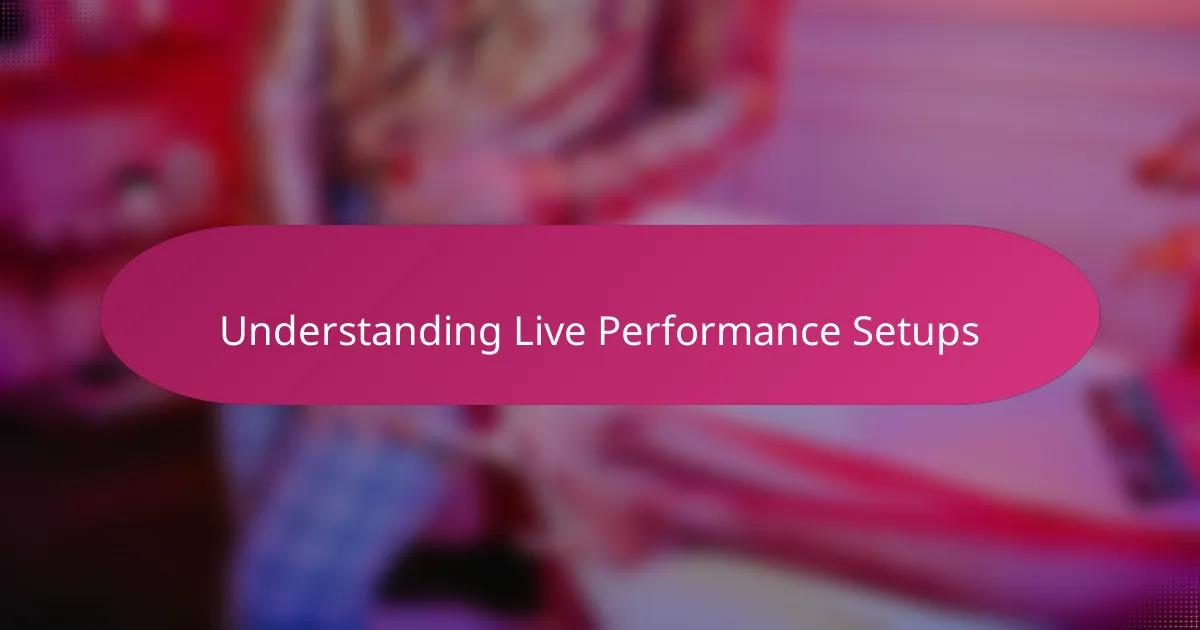
Understanding Live Performance Setups
When I first stepped on stage, the complexity of live performance setups really caught me off guard. It’s not just about the mic and speakers; it’s a delicate balance of sound engineering, equipment layout, and timing that can make or break the energy in the room. Have you ever wondered how some rappers can effortlessly switch between tracks while keeping the crowd hyped? That seamless flow comes from hours of fine-tuning their setups.
Understanding the gear—like mixers, monitors, and interfaces—is crucial. I remember a gig where a simple monitor placement changed everything for my performance. Suddenly, I could hear my voice clearly over the beats, and that confidence translated into a tighter delivery. It’s these small adjustments that often go unnoticed by the audience but make a huge difference behind the scenes.
Ultimately, a live performance setup is an extension of the artist’s style and needs. What works for one rapper might not fit another’s flow or stage presence. So, tailoring your setup isn’t just technical—it’s personal. Do you see your setup as part of your creative expression? I believe embracing that mindset transforms a good performance into an unforgettable one.
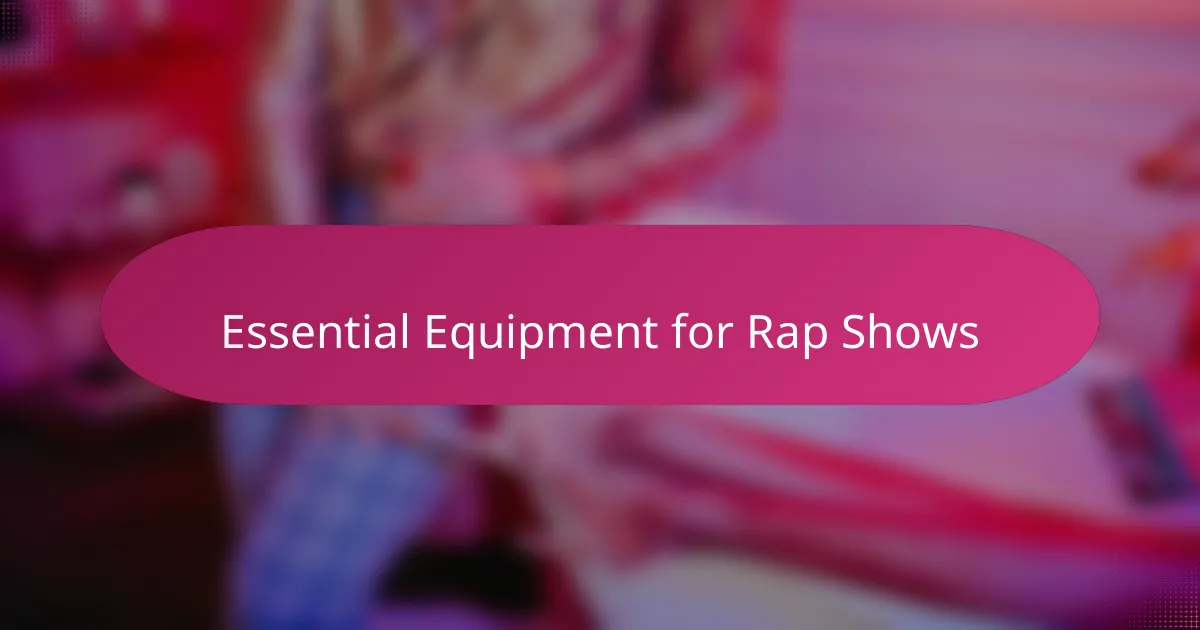
Essential Equipment for Rap Shows
For me, the microphone is non-negotiable—it’s the direct line to the crowd’s energy. I’ve learned that investing in a quality mic and getting comfortable with its sensitivity can change your whole vibe on stage. Have you ever felt that moment when your voice just cuts through perfectly? That’s the magic of the right mic.
Speakers and monitors are the unsung heroes of any rap show. I can’t count how many times a poorly positioned monitor threw me off, making me second-guess my flow. When you hear yourself clearly, it’s like having a conversation with the crowd instead of yelling into the void.
Don’t overlook the mixer and audio interface—they’re the brains behind the sound. Adjusting levels mid-performance isn’t just a tech task; it’s about reading the room and feeding the crowd exactly what they need. I’ve experienced that rush when every beat, every word, syncs perfectly through the setup—it’s electrifying.
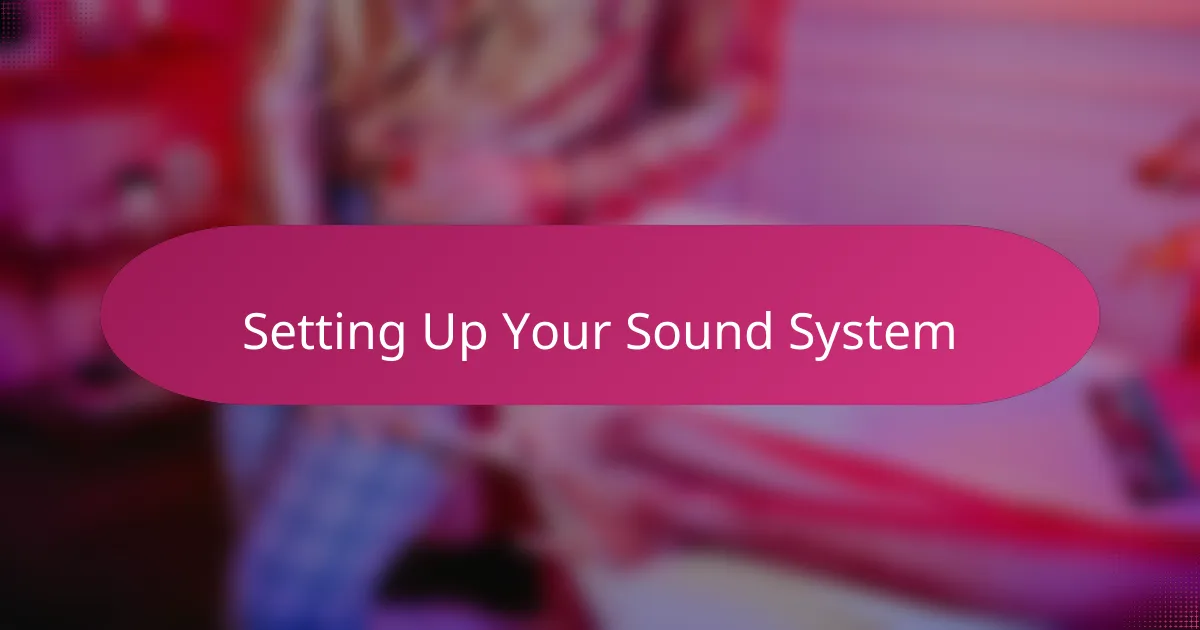
Setting Up Your Sound System
Setting up your sound system is where the magic really begins. I remember the first time I tweaked my EQ settings mid-show—suddenly, the vocals popped without overwhelming the bass, and the crowd’s reaction shifted instantly. Have you ever experienced that breakthrough moment when your sound finally feels alive and tailored to the room?
Placement of speakers and monitors can make or break your performance vibe. I’ve seen my flow tighten up just because I could clearly hear my voice bouncing back to me from the right angle. Don’t underestimate how much clarity and balance impact your confidence on stage.
Connecting all the gear—mixer, interface, and cables—can be a puzzle, but it’s worth mastering. Once, a loose connection caused a sudden drop in sound, and in that split second, I learned how crucial checking every cable is before hitting the stage. Would you want your audience to catch you fixing tech issues mid-verse? Neither would I.
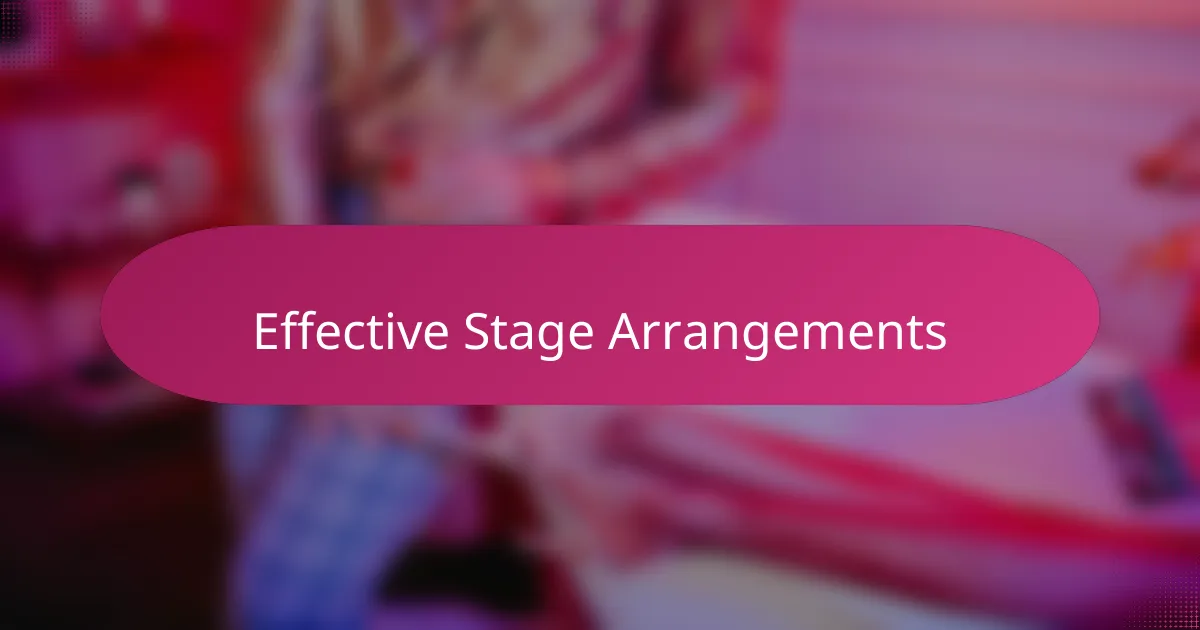
Effective Stage Arrangements
When it comes to effective stage arrangements, I’ve realized that the flow of movement is just as important as sound quality. Imagine trying to grab the mic or nod to your DJ but tripping over cables because the layout feels cramped—those moments break the connection with the audience. Have you ever adjusted your setup mid-show to create more space and suddenly felt a boost in your performance energy? I sure have, and it changes everything.
Lighting and stage props often get overlooked, but they play a huge role in guiding the crowd’s focus and enhancing the vibe. One time, a simple repositioning of a spotlight made me feel more in command and visible, which trickled down into a more confident delivery. Isn’t it wild how little things like that can shift the entire mood?
Another key for me is having a clear line of sight with my DJ or hype man. When I can lock eyes and cue each other effortlessly, the whole performance feels tighter and more natural. I’ve learned that those behind-the-scenes dynamics are often the unseen glue of a memorable live show. How do you set up your stage to foster that kind of connection?
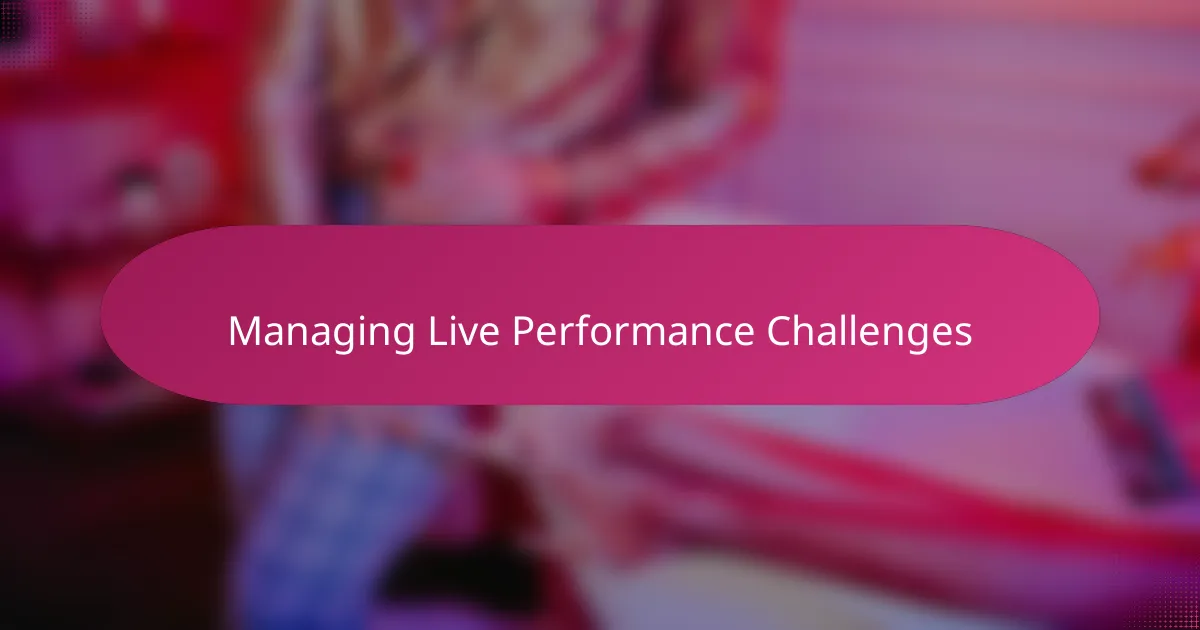
Managing Live Performance Challenges
Managing live performance challenges often comes down to staying calm when something unexpected happens. I remember a show where my equipment glitched mid-verse, and instead of freezing, I tapped into the crowd’s energy to ride through the moment. Have you experienced that sudden rush of adrenaline that turns a setback into a highlight? It’s like the audience can feel your resilience, and that connection keeps the performance alive.
Technical issues are probably the biggest challenge, from feedback squeals to dropped signals. Over time, I’ve learned that thorough soundchecks and backup plans aren’t just precautions—they’re lifesavers. For example, carrying extra cables and having a trusted tech person nearby gave me peace of mind and allowed me to focus more on my flow than fearing silence or chaos.
Then there’s the challenge of reading the room—sometimes the setup that worked all week just doesn’t click onstage. Adjusting on the fly means trusting your instincts and knowing your gear inside out. When I tweak my monitor levels mid-show because the beat overwhelms my vocals, it’s a small change that keeps my energy and delivery sharp. How often do you find yourself making those real-time fixes to keep the vibe tight?
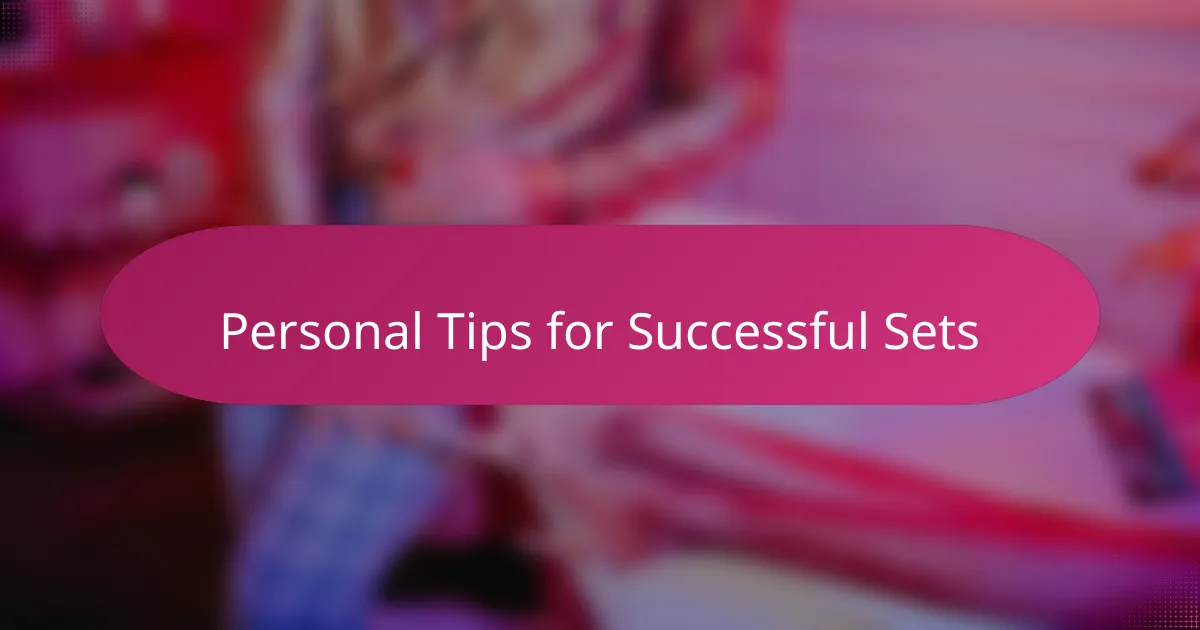
Personal Tips for Successful Sets
One tip I swear by is rehearsing your entire set exactly how you’ll perform it live. Running through transitions between songs helps me avoid awkward pauses that can kill momentum. Have you ever stumbled mid-show because you weren’t sure what came next? That’s a confidence killer I try hard to prevent.
Another crucial piece is staying connected with the audience. I find that making eye contact and reacting to the crowd’s energy keeps my delivery fresh and engaging. When I lock in with the room, it feels less like a scripted show and more like a shared experience—don’t you think that vibe makes all the difference?
Lastly, I always prepare for the unexpected by having backups ready—extra mics, cables, even a fallback playlist. One night, a sudden mic dropout could have ended my set early, but because I was prepared, I turned it into a moment where the crowd actually cheered louder. That taught me how resilience and readiness can turn challenges into highlights.
